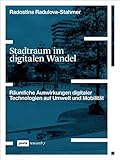Stadtraum im digitalen Wandel : Räumliche Auswirkungen digitaler Technologien auf Umwelt und Mobilität / Radostina Radulova-Stahmer.
Material type: TextSeries: JOVIS research ; 7Publisher: Berlin : JOVIS, [2023]Copyright date: 2024Description: 1 online resource (248 p.) : 74 farb. und s/w AbbContent type:
TextSeries: JOVIS research ; 7Publisher: Berlin : JOVIS, [2023]Copyright date: 2024Description: 1 online resource (248 p.) : 74 farb. und s/w AbbContent type: - 9783868597714
- 9783868597875
- Digitalisierung
- Gemeinwohl
- HafenCity Hamburg
- Informationstechnologie
- Kommunikationstechnologie
- Künstliche Intelligenz
- Mobilität
- Raumwirksamkeit
- Seestadt Aspern
- Smart City Waagner Biro Graz
- Smart City
- Stadtqualität
- Städtebau
- Urbanismus
- digitale Transformation
- ressourcenschonend
- vernetzte Quartiere
- ARCHITECTURE / Sustainability & Green Design
- climate change
- digital transformation
- environmental pollution
- information and communication technologies
- resource scarcity
- urban digitalization processes
- urban space
- 307.1
- online - DeGruyter
- Issued also in print.
| Item type | Current library | Call number | URL | Status | Notes | Barcode | |
|---|---|---|---|---|---|---|---|
 eBook
eBook
|
Biblioteca "Angelicum" Pont. Univ. S.Tommaso d'Aquino Nuvola online | online - DeGruyter (Browse shelf(Opens below)) | Online access | Not for loan (Accesso limitato) | Accesso per gli utenti autorizzati / Access for authorized users | (dgr)9783868597875 |
Browsing Biblioteca "Angelicum" Pont. Univ. S.Tommaso d'Aquino shelves, Shelving location: Nuvola online Close shelf browser (Hides shelf browser)

|

|

|

|

|

|

|
||
| online - DeGruyter Competition of Legal Systems and Harmonization of European Private Law : New Paths in a Comparative Perspective / | online - DeGruyter Festschrift für Ulrich Magnus : zum 70. Geburtstag / | online - DeGruyter Common European Sales Law Meets Reality / | online - DeGruyter Stadtraum im digitalen Wandel : Räumliche Auswirkungen digitaler Technologien auf Umwelt und Mobilität / | online - DeGruyter Spatial Expeditions / | online - DeGruyter Exhibiting Matters / | online - DeGruyter Territorial Justice / |
Frontmatter -- Inhalt -- Ausgangslage -- Rahmenbedingungen und Begriffsannäherung -- Fotoessay -- Typenbildung der Raumwirksamkeit -- Räumliche Auswirkungen – Codierung Expert*inneninterviews -- Kartografische Untersuchung -- Szenarien – Räumliche Potenziale digitaler Technologien -- Wege der Potenzialerschließung -- Gesamtbetrachtung – Ergebnisse, kritische Reflexion und Einordnung -- Fazit und Ausblick -- Endnoten -- Literaturverzeichnis -- Expert*innenverzeichnis -- Nachwort – Markus Neppl -- Zusammenfassung -- Danksagung -- Die Autorin
restricted access online access with authorization star
http://purl.org/coar/access_right/c_16ec
All around the world, new technologies are being implemented to help meet modern challenges such as climate change, pollution, and resource scarcity in the context of the digital transformation. The use of AI, ICT, real-time information, and Big Data is significantly changing the shape of the city and, as such, making new demands on urban spaces.This book reveals the specific and vital spatial dimension of urban digitalization processes at neighborhood level. Using three examples from German-speaking countries, Radostina Radulova-Stahmer demonstrates the necessity of orienting urban development towards the common good in in the context of the digital transformation.
Weltweit werden in Städten unter dem Vorzeichen der digitalen Transformation neue Technologien eingesetzt, um den aktuellen Herausforderungen wie Klimawandel, Umweltverschmutzung und Ressourcenknappheit zu begegnen. Dieser Einsatz von künstlicher Intelligenz, Informations- und Kommunikationstechnologie, Echtzeitinformation und Big Data beeinflusst maßgeblich die Form des Stadtraums und schafft damit neue Ansprüche an ihn.Das Buch stellt die spezifische und kritische räumliche Dimension von urbanen Digitalisierungsprozessen auf Quartiersebene dar. Anhand dreier Beispiele aus dem deutschsprachigen Raum, arbeitet Radostina Radulova-Stahmer die Notwendigkeit einer gemeinwohlorientierten Ausrichtung der Stadtentwicklung im Kontext des digitalen Wandels heraus.
Issued also in print.
Mode of access: Internet via World Wide Web.
In German.
Description based on online resource; title from PDF title page (publisher's Web site, viewed 26. Aug 2024)


